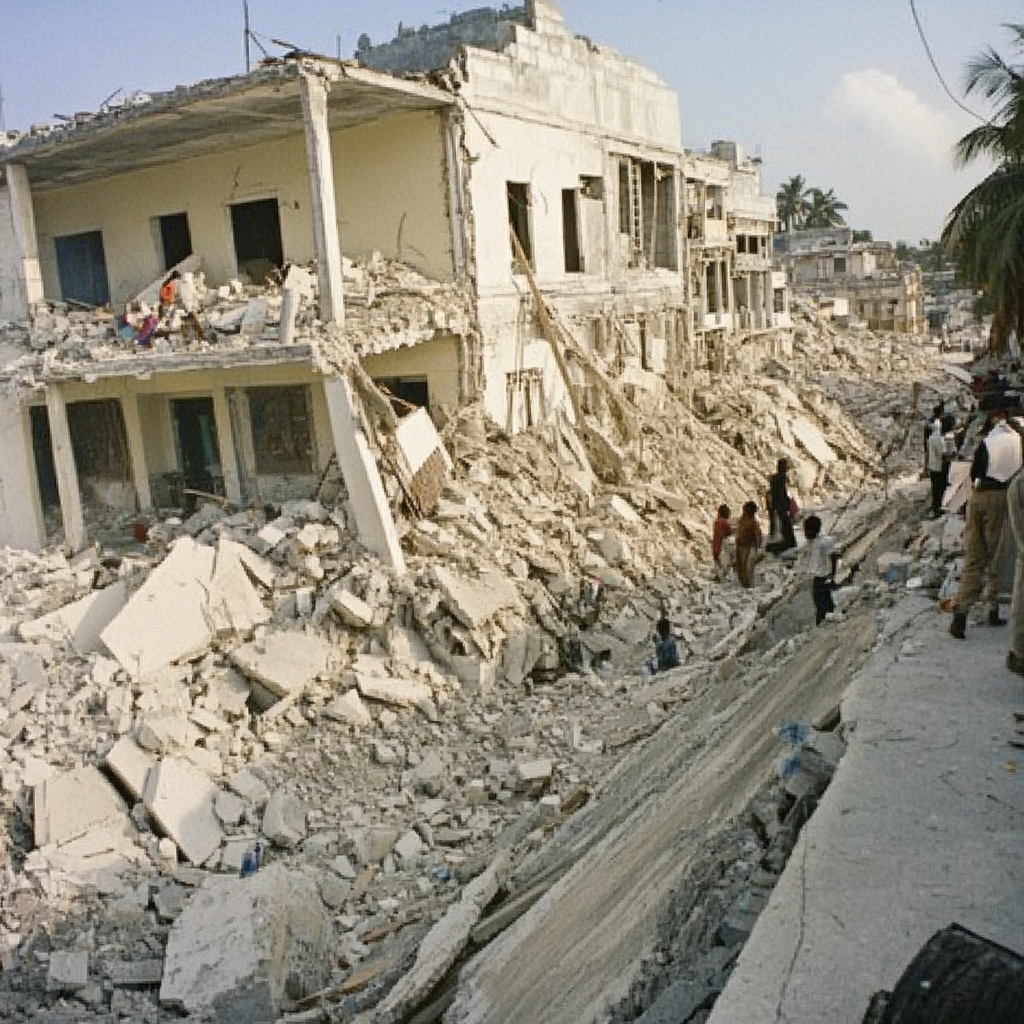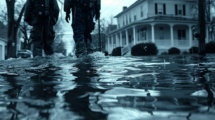In the wake of the devastating 2010 Haiti earthquake, a myriad of conspiracy theories sprang up, one of the most prominent being that the 2010 Haiti earthquake was caused by a secret US earthquake weapon. This blog post seeks to dismantle such myths and provide a factual recounting of events based on credible scientific evidence and expert testimonies.
The initial shock and chaos following the earthquake created fertile ground for wild speculations and elaborate theories as people searched for answers to make sense of the catastrophic event.
The myth posited that hidden technology, potentially wielded by the US government, was responsible for triggering the quake that wreaked havoc in Haiti. This theory swiftly gained traction through various online platforms and fringe groups, adding an extra layer of confusion to an already dire humanitarian crisis. The purpose of this blog post is to analyze these conspiracy claims thoroughly, highlighting why they are unfounded and how they complicate relief efforts.
By delving into historical contexts, scientific data, and expert testimonials, we’ll demonstrate why natural seismic activity-not clandestine weapons-was responsible for this tragic event. Through careful examination, we aim to foster an informed understanding of both the 2010 Haiti earthquake itself and the dangers posed by unverified conspiracy theories. In doing so, we hope to underscore the importance of relying on verified information during times of crisis.
Background
The 2010 Haiti earthquake struck on January 12, with a magnitude of 7.0, devastating the nation’s capital, Port-au-Prince, and its surrounding areas. The quake’s epicenter was near the town of Léogâne, approximately 25 kilometers (16 miles) west of Port-au-Prince.
This catastrophic event resulted in the deaths of an estimated 230,000 people and left another two million displaced. In addition to the massive human toll, critical infrastructure such as hospitals, schools, and government buildings were destroyed or severely damaged.
The immediate impact on Haiti was staggering in scale and severity. Hundreds of thousands were injured amidst the crumbled structures, creating an overwhelming need for medical aid while healthcare facilities lay crippled themselves. The international community rallied quickly; however, logistical challenges such as disrupted communication lines and blocked roads impeded relief efforts initially. Displacement camps sprang up across the ruined landscape as Haitians confronted a colossal humanitarian crisis that would take years to address adequately.
Seismic activity is not uncommon in this region due to the island’s location atop several tectonic plate boundaries-specifically where the Caribbean Plate interacts with both the North American Plate and Gonâve Microplate. Historic records reveal that Haiti has experienced significant earthquakes before, though none with such catastrophic consequences in recent memory.
The geological context underscores that natural tectonic shifts fueled by these plates’ movement are inevitable triggers for seismic events-which starkly contrasts conspiracy theories suggesting otherwise fanciful causes like claiming the 2010 Haiti earthquake was caused by a secret US earthquake weapon.
| Event | Data |
|---|---|
| Date | January 12, 2010 |
| Magnitude | 0 |
| Casualties | ~230,000 deaths |
The Origin of the Secret US Earthquake Weapon Myth
The 2010 Haiti earthquake was a tragedy that left deep scars on the nation, but it also gave rise to various conspiracy theories, one of which claimed the disaster was artificially triggered by a secret US earthquake weapon. The theory started circulating shortly after the earthquake and gained traction through certain online platforms and outspoken figures in the conspiracy community.
This notion wasn’t entirely new; it piggybacked on pre-existing suspicions about government experiments and advanced weaponry purported to control natural disasters.
The history of associating natural calamities with human-made interventions dates back decades. From cloud-seeding during wartime to HAARP (High-Frequency Active Auroral Research Program) debates, there has long been public fascination and fear around the potential for governments to manipulate environmental conditions.
In this web of historical context, theorists seized upon the devastation in Haiti as another “proof” point. Social media accelerated these ideas, making it easy for anyone, anywhere, to speculate about high-tech machinations behind seemingly natural events.
Interestingly, this specific theory involving Haiti was amplified by prominent voices who had previously engaged in similar conspiracy-related narratives. These figures capitalized on existing mistrust toward governmental agencies and military establishments.
Claims were often made without sufficient evidence yet reached massive audiences due to charismatic delivery and tactical use of emerging social media channels at the time. The argument suggested that technology from undisclosed defense projects could be responsible for triggering tectonic shifts-an assertion not grounded in any scientific reality but compelling enough to capture widespread attention.
| Key Figure | Platform |
|---|---|
| Jesse Ventura | Television Shows |
| Alex Jones | Websites and Radio Shows |

Analysis of the Conspiracy Theory Claims
One of the core claims made by conspiracy theorists is that the 2010 Haiti earthquake was caused by a secret US earthquake weapon, often referred to as HAARP (High-Frequency Active Auroral Research Program). Advocates of this theory argue that HAARP has the capability to manipulate the Earth’s tectonic plates and create artificial earthquakes. They maintain this claim despite a lack of scientific evidence or credible testimonies from experts in geophysics or seismology.
To support their assertions, conspiracy theorists present selective pieces of information and often misuse legitimate scientific data. For instance, they cite anomalies in weather patterns or unexplained phenomena observed around the time of the earthquake.
These pieces of so-called “evidence” are usually taken out of context or interpreted incorrectly. Additionally, they might reference patents and research papers discussing electromagnetic waves’ effects on geological formations without acknowledging that these documents do not support any practical implementation capable of causing an earthquake.
When analyzing the plausibility and logic behind these claims, several inconsistencies become evident. First, the HAARP facility’s primary function is related to studying ionospheric phenomena and its interaction with radio signals, not manipulating underground tectonics. Secondly, natural geological processes such as fault slippage account for earthquakes far more convincingly than speculative conspiracies about man-made interventions.
Furthermore, experts universally agree that initiating a tectonic event like the one experienced in Haiti would require an energy release on a scale not achievable by human technology. The focus on unsupported theories distracts from genuine efforts to understand and mitigate seismic risks through science-based approaches.
Scientific Disproof and Expert Testimonies
Understanding the science behind earthquakes is crucial in discrediting myths, such as the claim that the 2010 Haiti earthquake was caused by a secret US earthquake weapon. Earthquakes result from the movement of tectonic plates, which are massive slabs of Earth’s lithosphere constantly moving on top of a more fluid asthenosphere.
When these plates grind against each other or one plate is forced below another, stress builds up until it is released as seismic energy. This natural process explains earthquakes without invoking human intervention or secretive technologies.
Seismologists and geophysicists have been vocal in dismissing the theory that an earthquake weapon was involved. For instance, Dr. John Ebel from the Weston Observatory stated unequivocally that there is no scientific basis for such claims.
According to him, not only is it technologically unfeasible to generate an artificial earthquake with the magnitude observed in Haiti (7.0), but extensive global seismic networks would detect any anomalies indicative of man-made seismic activity, none of which were found in January 2010.
Extensive research and data analysis support that the 2010 Haiti earthquake was naturally occurring. Detailed studies conducted by the United States Geological Survey (USGS) and the international seismic community traced the event to a strike-slip fault where two segments of Earth’s crust slid past each other horizontally.
This geological setting has a long history of tectonic movement, indicating that such an earthquake was inevitable due to natural causes rather than any supposed technological interference. These findings highlight the importance of grounding our understanding and responses to natural disasters in clear and rigorous scientific evidence rather than succumbing to unfounded conspiracy theories.
Impact of the Myth on Public Perception and Recovery Efforts
The propagation of the myth that the 2010 Haiti earthquake was caused by a secret US earthquake weapon has significantly impacted public perception and recovery efforts in various ways. Firstly, it has fostered a sense of distrust towards international aid organizations and government initiatives.
Many Haitians and international observers became skeptical of foreign assistance, doubting the intentions behind humanitarian aid. This skepticism can lead to reluctance or even refusal to accept aid, which is detrimental in the aftermath of such a devastating natural disaster where timely help is crucial.
Moreover, the spread of conspiracy theories can delay vital recovery processes. When people are preoccupied with deciphering and debating these myths, they may shift their focus away from urgent relief efforts needed to rebuild infrastructure and provide medical care to survivors.
For instance, community meetings that could have been used for organizing effective distribution of resources might instead be diverted into discussions about unsubstantiated claims. This diversion dilutes the efficiency and effectiveness of on-ground operations aimed at mitigating disaster impacts.
Furthermore, such myths undermine scientific education and literacy among the general population. When conspiracies gain traction, they often perpetuate ignorance about natural phenomena like earthquakes. Understanding tectonic plate movements and seismic activity becomes overshadowed by sensationalist rhetoric rather than factual information.
Public mistrust in scientific explanations makes it harder for authorities to implement preventive measures for future disasters as part of broader risk management strategies. Hence, combating misinformation not only involves direct debunking but also improving science communication so that accurate knowledge prevails over baseless myths.
To address these challenges, several steps have been taken by organizations dedicated to fighting misinformation during disaster responses:
- Collaboration with local influencers who hold public trust to disseminate accurate information.
- Development of educational campaigns explaining natural disasters in simple terms.
- Partnership with media outlets committed to factual reporting over sensationalism.
By employing these strategies, efforts continue to refocus public attention on legitimate recovery activities and enhance overall resilience against future seismic events through informed preparedness.
Media’s Role in Propagating or Disproving the Myth
Both traditional and social media played significant roles in either propagating or disproving the myth that the 2010 Haiti earthquake was caused by a secret US earthquake weapon. In the immediate aftermath of the disaster, traditional media sources such as television news programs and newspapers focused on covering the extent of the damage, humanitarian efforts, and survivor stories.
However, some media outlets inadvertently gave a platform to conspiracy theorists by not rigorously fact-checking their claims or by presenting sensationalized stories that garnered public attention.
Social media platforms proved to be fertile ground for the rapid spread of conspiracy theories related to the earthquake. Within hours of the disaster, tweets, Facebook posts, and YouTube videos began circulating outrageous claims that ranged from government cover-ups to clandestine use of exotic weapons.
These messages were often shared tens of thousands of times before being scrutinized or debunked. The viral nature of these posts contributed significantly to shaping public perception, making it challenging for factual information to gain as much traction.
Journalists taking an investigative approach played a crucial role in debunking these myths. Many reputable news organizations made concerted efforts to interview seismologists, geophysicists, and other experts who could explain why it is scientifically impossible for an earthquake to be artificially induced via a secret weapon.
By presenting these expert testimonies alongside compelling scientific data – including historical patterns of seismic activity in Haiti – credible journalists helped steer public discourse back toward evidence-based understanding. Despite these efforts, it remains evident that combating misinformation requires continuous vigilance from both the media and scientific communities.

Conclusion
The Necessity of Critical Thinking
In reviewing the myth that the 2010 Haiti earthquake was caused by a secret US earthquake weapon, it becomes increasingly clear that critical thinking and scientific literacy are vital. This conspiracy theory is but one example of how misinformation can proliferate during times of tragedy and uncertainty.
To combat such myths effectively, it is essential to encourage a culture of skepticism when confronted with extraordinary claims-those lacking substantial evidence should be met with rigorous scrutiny. By highlighting credible scientific explanations for natural disasters, the public can develop a more nuanced understanding that helps diminish the space in which falsehoods thrive.
The Role of Reliable Sources
One key lesson from debunking this particular conspiracy theory is the importance of relying on well-established, credible sources for information. The speed at which misinformation can spread across social media and other platforms complicates immediate responses to crises. Therefore, media outlets must prioritize accurate reporting over sensationalism.
Expert testimonies from seismologists and geophysicists played a crucial role in establishing that tectonic plate movements were the natural cause of the 2010 Haiti earthquake. Their insights underscore the importance of consulting scientific authorities rather than succumbing to unfounded speculation.
Strategies for Addressing Future Myths
Lastly, tackling future instances where conspiracy theories might emerge requires both proactive and reactive strategies. Educational initiatives focused on seismic science and disaster preparedness can provide communities with foundational knowledge that guards against mistruths.
Additionally, swift action by media outlets to disprove myths through factual reporting ensures that dangerous narratives are curtailed before gaining substantial traction. International bodies and recovery organizations may also need to engage in targeted campaigns aimed at debunking harmful conspiracies rapidly so they do not impede humanitarian efforts or distort public perception.
By collectively emphasizing education, credibility, and prompt responses to prevent fires of misinformation from spreading, society will be better equipped to handle similar situations in the future while maintaining trust in factuality over fiction.
References and Further Reading
In conclusion, the tale that the 2010 Haiti earthquake was caused by a secret US earthquake weapon has been thoroughly disproven through rigorous scientific examination and expert testimony. As detailed throughout this article, the natural tectonic dynamics in the region provide a comprehensive explanation of why this tragic event occurred. The spread of such conspiracy theories not only distorts reality but also hampers recovery efforts by diverting attention and resources from actual needs.
This case underscores the critical importance of relying on credible sources and scientific evidence when addressing complex phenomena like earthquakes. Misinformation can thrive in times of crisis, preying on fear and uncertainty, but it is precisely during these times that facts and accuracy are most essential. By debunking such myths through informed discourse and education, we can foster a more resilient society capable of responding effectively to natural disasters.
Ultimately, combating conspiracy theories requires a concerted effort from scientists, media professionals, and educators alike. It involves promoting transparency, enhancing public understanding of scientific principles, and encouraging critical thinking. Only by working together can we ensure that truth prevails over falsehoods, enabling communities to build back stronger and more informed after devastating events like the 2010 Haiti earthquake.




